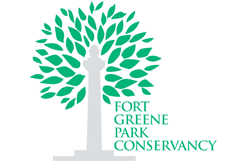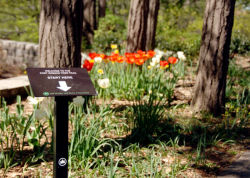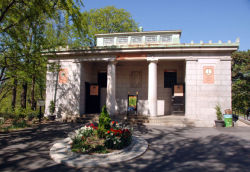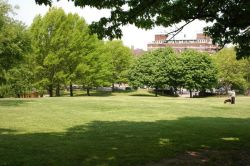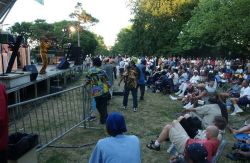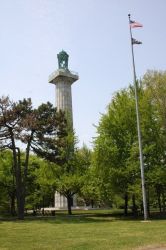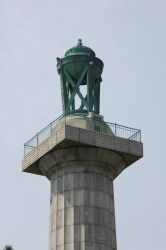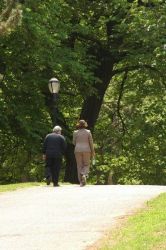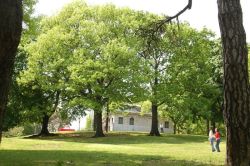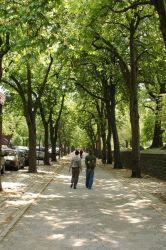Fort Greene Park
Fort Greene Park
Fort Greene Park is a landmark, cherished for its history, rolling landscape, trees, and monuments. For 150 years, this noble park has served as a rus in urbe—a country in the city—for Brooklyn. In 1776 American Major General Nathanael Greene supervised the construction of Fort Putnam on high ground that is now part of the park. During the Battle of Long Island, the Continental Army withdrew from the fort and retreated to Manhattan. The British held thousands of captives on prison ships anchored in the East River. Over 11,500 men and women died of overcrowding, contaminated water, starvation, and disease aboard the ships, and their bodies were hastily buried along the shore. These brave patriots represented all thirteen colonies and at least thirteen different nationalities. In 1808 the remains of the prison ship martyrs were buried in a tomb on Jackson Street (now Hudson Avenue), near the Brooklyn Navy Yard.
The Brooklyn fort was renamed for General Greene and rebuilt for the War of 1812. When the threat of war passed, locals enjoyed visiting the grounds of the old fort for recreation and relaxation. The City of Brooklyn designated the site for use as a public park in 1845, and newspaper editor Walt Whitman rallied popular support for the project. From the pages of the Brooklyn Daily Eagle, he appealed for a pleasant retreat for city dwellers, "a place of recreation. . .where, on hot summer evenings, and Sundays, they can spend a few grateful hours in the enjoyment of wholesome rest and fresh air." In 1847 the legislature approved an act to secure land for Washington Park on the site of the old fort. The improvements were complete by 1850.
In 1867 landscape architects Frederick Law Olmsted and Calvert Vaux, designers of Central and Prospect Parks, were engaged to prepare a new design for Washington Park and a crypt for the remains of the prison ship martyrs. At the top of the hill was a trellised walk approaching two flights of steps that led down to a circular parade ground in the northwest corner of the park. Olmsted and Vaux proposed that the rest of the hilly site would be "somewhat closely planted, and . . .so laid out that it will offer a series of shady walks that will have an outlook over open grassy spaces." Washington Park was renamed for Fort Greene in 1897, less than a year before Brooklyn was consolidated into greater New York City. The street that bounds the park on the east is still known as Washington Park.
With funds available for a permanent monument to the prison ship martyrs, the renowned architectural firm of McKim, Mead and White was hired in 1905. They designed a new entrance to the crypt and a wide granite stairway leading to a plaza on top of the hill. From its center rose a freestanding Doric column crowned by a bronze lantern; President-elect William Howard Taft attended the monument’s dedication in 1908. McKim, Mead and White also built a neoclassical public restroom (now used as a visitor center). Another series of renovations in the 1930s further enhanced the classical design of the park. Parks architect Gilmore D. Clarke regraded the grounds, added new trees and shrubs, replaced the winding paths with more formal walks, remodeled the playgrounds, and created new spaces for athletic activities. As Brooklyn’s first official park, Fort Greene has received 150 years of alterations and renovations. The $1,166,000 capital reconstruction of the park’s northwest playground was funded by Council Member Mary Pinkett in 1995. The project included installing a new spray shower/north arrow rosette, safety surfacing, pavements, benches, and fencing; reroofing the public restroom; reconstructing the flagpole and the drainage and water systems; and planting new trees, shrubs, and groundcover. The playground’s design pays tribute to the Revolutionary War history of Fort Greene. The new play equipment resembles fortresses, and the new weathervane on top of the public restroom is shaped like a bald eagle and banner reading "1776." Thirteen stone pillars feature bronze plaques that identify the state trees and animals of the original colonies.
Check out your park's Vital Signs
Clean & Safe
Green & Resilient
Empowered & Engaged Users
Share your feedback or learn more about how this park is part of a
Vital Park System
Contacts
Director of Fort Greene Park: (718) 722-3218

